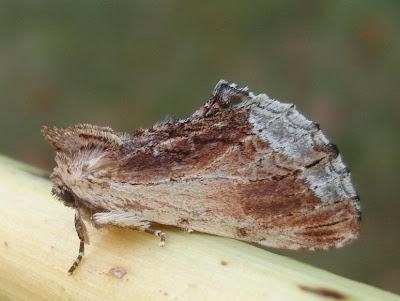At least a handful of comma butterflies have been flying around the country park in recent days. This one pictured above on Sunday 28th, posed nicely on the end of a flowering head of some grass, although the grass stalk was swaying about in the breeze.
Other butterflies seen at the park have included ringlet, peacock, speckled wood, meadow brown, gatekeeper, small skipper, Essex skipper, large skipper, small white and large white.
A group of 20 purple hairstreaks were seen east of Meeting Lane at Gyants Marsh on Monday 29th by Steve Entwistle.
A group of ten ruddy darters were gathered on the park cliff-top, sheltering from the sea-breeze behind some of the bushes. This colourful male was one of several in the area. Elsewhere migrant hawker,blue-tailed damselflies and azure damselflies were seen about the park too.
A common sandpiper on the pools in the park's fields on Tuesday 30th was the first one noted at the park this year. Also here were 10 black-tailed godwits, the first returning snipe, 2 lapwing, 9 greylag geese and 8 teal. At the pond 6 little egrets roosted late afternoon and a shoveler and 3 teal were present here.
The family of kestrels left the tree a week previously and the young have now been in the trees near the cliff-top calling out loudly whenever a parent returns with food.
A little owl perched on top of a telegraph post near the East Mersea pub at dusk on Sunday 28th. A large flock of about 2000+ black-headed gulls were circling above West Mersea on the warm Sunday evening, catching the masses of flying ants in the air.
Martin Cock saw a green sandpiper at Maydays farm during his visit there on Monday.
Amongst the forty species of macro moth caught at the park on Monday 29th was this neatly camouflaged maple prominent. This is an annual visitor to the trap at the park but only one or two individuals noted each year.
Up to ten lunar-spotted pinions have been noted on some mothing evenings, so fairly widespread and at its peak of emergence at the moment. Some of these individuals have a nice dark red colouration.
The only other new moth noted for the season was the first copper underwing.






No comments:
Post a Comment